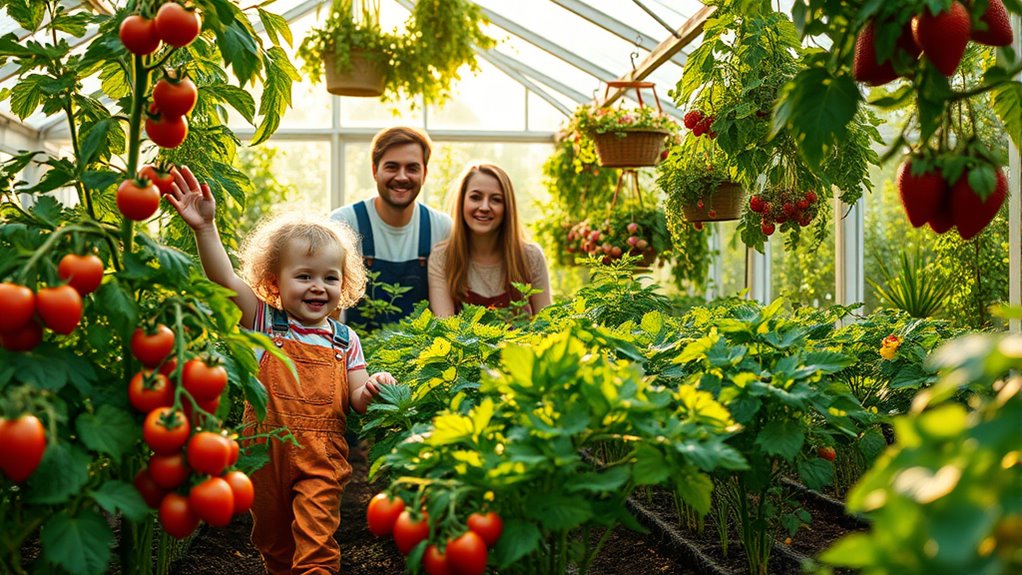Growing a family garden in a greenhouse is a wonderful way to bring everyone together. Kids get hands-on experience, learn about plant care, and develop responsibility while working side by side. It also boosts teamwork, sparks curiosity, and creates lasting memories. As you plan and nurture your garden, you’ll see how shared responsibilities grow stronger bonds. If you keep exploring, you’ll discover even more ways to make gardening a fun, educational family adventure.
Key Takeaways
- Gardening in the greenhouse involves kids early, boosting their engagement and sense of responsibility.
- Families collaboratively plan and assign tasks, fostering teamwork and shared purpose.
- The greenhouse setting provides a controlled environment for teaching plant care and pest management organically.
- Kids develop curiosity and problem-solving skills through hands-on involvement and pest observation.
- Working together in the greenhouse strengthens family bonds and creates memorable learning experiences.

Have you ever wondered why families who garden together often share a stronger bond? It’s because gardening creates a shared purpose, a chance to work side by side, and a way to nurture something tangible. When you involve kids in the process, it becomes even more meaningful. One of the first steps to successful family gardening is good garden planning. You’ll want to choose plants suited to your climate, space, and the kids’ ages. Planning helps you set realistic goals, assign tasks, and ensure everyone has a role. When kids help decide what to grow, they feel more invested. It’s important to involve them early, showing how to prepare the soil, select seeds, and map out the layout. This shared planning process teaches responsibility and patience, as they see how each step contributes to the final harvest. It’s also a perfect time to discuss pest management, which is an essential part of gardening. Kids should learn that pests are natural but need to be controlled to protect their plants. Instead of using harsh chemicals, you can teach them about organic pest management techniques, like introducing ladybugs or using natural repellents. This way, they understand the importance of caring for the environment while safeguarding their garden. As they observe pests and learn about their habits, kids develop a sense of curiosity and problem-solving skills. You can make pest management a fun, educational activity—checking plants regularly, identifying common pests, and figuring out eco-friendly solutions together. This hands-on approach encourages responsibility and respect for nature. Plus, it helps kids realize that gardening isn’t just about planting seeds but also about maintaining and protecting their garden. When they see the direct impact of their efforts—like fewer bugs or healthier plants—they feel accomplished and more connected to the process. Incorporating pest management into your garden planning also teaches patience and adaptability. Sometimes, pests may be stubborn, and you’ll need to try different strategies. This teaches resilience and critical thinking. Additionally, understanding beneficial insects can turn pest management into an engaging learning experience. Overall, gardening with kids isn’t just about producing vegetables or flowers; it’s about creating a shared experience rooted in planning, responsibility, and environmental awareness. When everyone understands the importance of pest management and the steps involved, it becomes a team effort. This collaborative process strengthens family bonds, encouraging communication, teamwork, and mutual respect. Gardening becomes a family adventure—full of learning, discovery, and growth—making the time spent together truly special.
Frequently Asked Questions
How Can I Start a Family Greenhouse With Limited Space?
You can start a family greenhouse in limited space by using indoor herb gardening and container planting techniques. Choose small pots or vertical planters to maximize space, and pick easy-to-grow herbs like basil or mint. Involve your kids in planting and caring for the herbs, making it fun and educational. This approach keeps your greenhouse manageable while fostering family teamwork and a love for gardening.
What Are the Best Plants for Kids to Grow Indoors?
You should start with indoor herbs like basil, mint, or parsley, as they’re easy for kids to grow and maintain. Easy vegetables like lettuce, radishes, and cherry tomatoes also thrive indoors and can be harvested quickly. Encourage your kids to water regularly and watch their plants grow, making gardening fun and educational. These plants teach responsibility and provide fresh flavors for your family’s meals.
How Do I Teach Children About Sustainable Gardening Practices?
You can teach kids about sustainable gardening by showing them composting techniques, explaining how compost enriches soil naturally, and involving them in the process. Emphasize water conservation by demonstrating how to water plants efficiently, like using drip irrigation or collecting rainwater. Make it fun by creating a family routine around these practices, and encourage their curiosity by answering questions and letting them observe the positive impact on the garden.
What Safety Precautions Should Kids Follow in the Greenhouse?
In the greenhouse, safety isn’t optional — it’s your top priority. Kids must follow strict chemical safety rules, like wearing gloves and goggles, to prevent any mishaps. Proper supervision is vital; never let children handle pesticides or sharp tools alone. Teach them to stay clear of hot surfaces, keep pathways clear, and always ask an adult if they’re unsure. This way, everyone stays safe and the greenhouse stays a fun, learning space.
How Can Gardening Activities Be Adapted for Different Age Groups?
You can adapt gardening activities for different age groups by providing age-appropriate tools, like small trowels for young children and larger ones for older kids. Incorporate gardening games to keep younger kids engaged and learning, such as scavenger hunts for different plants. For older kids, challenge them with composting or planting schedules, encouraging responsibility and teamwork. Tailoring tasks guarantees everyone enjoys and benefits from the gardening experience.
Conclusion
Gardening as a family not only nurtures plants but also strengthens bonds and teaches responsibility. Did you know that kids who garden are 50% more likely to eat fruits and vegetables? So, next time you step into the greenhouse, remember you’re planting more than seeds—you’re cultivating teamwork and healthy habits that last a lifetime. Keep encouraging those little green thumbs; your family’s growth story is just beginning!









